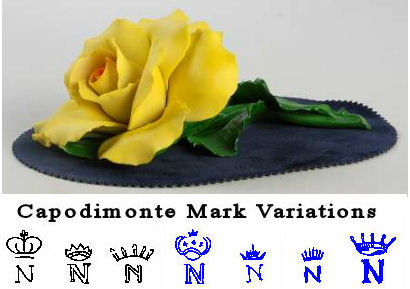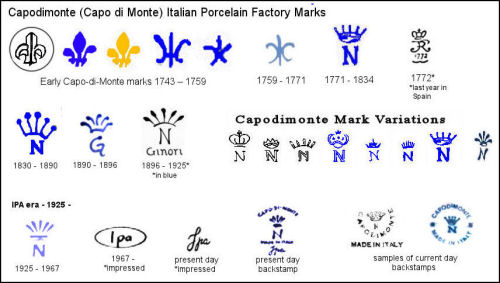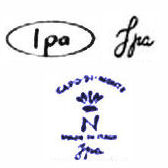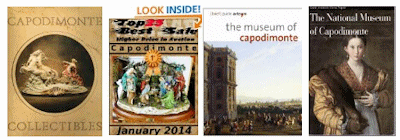How To Date And Recognize Capodimonte Marks

How do you tell if a Capodimonte piece is real?
Capodimonte, (also spelled Capo Di Monte), “Made in Italy” porcelain markings have changed over the years. Factory marks, maker’s marks, and trademarks have grown from a simple crude fleur-de-lis of King Charles VII to the famous “N” and Crown recognized today.
The chart and timeline below show the marks used by the original Royal Factory and the independent porcelain factories that grew around the Royal franchise for Neapolitan Capo-de-monte porcelains from the King’s time until now.

Get a full-size PDF Printable Reference Page
Capodimonte (or Capo-di-Monte) Italian Porcelain
Capodimonte porcelain is named for the Neapolitan region of Italy (and Spain, for a while) where it was made, not for a single factory or maker. The first manufactury of this hard-paste porcelain was the Royal Factory, built in “The Royal Wood of Capo-di-Monte” in Naples, Italy. Still, earlier porcelains made in Spain were also authentic Capodimonte pieces.
*See the history of Capodimonte Porcelain
Early Capo-di-Monte marks 1743–1759
The early Capodimonte pieces, created before the first ‘Royal Factory’ (pre-1743), used the Fleur-de-Lis symbol. The Fleur-de-Lis in a circle was impressed or inscribed on most pieces, while the solid Fleur-de-Lis was a painted under-glaze mark in blue or gold. If you find yourself with one of these trademarks it’s like hitting the lottery.

The two ‘stylized’ Fleur-de-Lis on the right were primarily used on service-ware pieces that were not deemed as ‘artful’ as pieces with the two above-left trademarks.
Authenticity Note: Although later in this period most figurines were also marked with the broad fleur-de-lis, many of the earlier ones were unmarked. In this case, the style of modeler Giuseppe Gricci must be considered. His designs were known for several distinctive features, ie. the figurine heads were disproportionally small – relative to body size, most figurines were miniatures, (not the 6″ – 10″ figurines of later productions), and their bases were generally “rocky. [1]
The Capo-di-Monte Marks Gap 1759–1771

King Charles III moved the Capodimonte production to Spain in 1759 when he became Spain’s King Charles I. Although the porcelain was exactly the same, it was officially Spanish porcelain during this period. This blue ‘stylized’ version of the original Fleur-de-Lis was used for production from the Spanish Buen Retiro factory near Madrid.
Capo-di-Monte marks 1771–1834

The first use of the Neapolitan “N” topped with a 5-point crown, (coronet), was in 1771. Spanish King Ferdinand I had a Royal Factory built in Naples, and even though it was not completed until 1772, the blue “N” and crown were used for production pieces made that year in the Spanish Factory, and continued to be used after the manufacturing process moved back to Naples. It was used until 1834.
Important Note: The Neapolitan “N” and crown were never trademark protected. There have been many variations with different fonts of the “N” and styles of the crown or coronet. Technically, any porcelain maker could use the mark and claim to be Capodimonte porcelain. And many have.
To be sure of the authentication, other factors must also be considered, such as; factory marks and back-stamps, even design and art styles that are known and recognized.
If you have a piece with these markings, extra effort must be made to authenticate your piece to this period. It makes a great difference in value.

Capo-di-Monte marks 1772

This Capodimonte mark was used on pieces made in the last year of the Buen Retiro factory production.
Capo-di-Monte Ginori mark 1830–1890

This version of the Capodimonte mark, (5 points representing a crown, but not drawn as a crown), was used by the Ginori factory in Doccia, Florence. Ginori only represented their porcelain as Capodimonte. It was not made in Neapolitan factories, so, at this time, it was not “true” Capo-di-Monte porcelain.
Capo-di-Monte Ginori Mark 1896–1925 (approx.)

This version of the ‘crown’ mark with the name “Ginori” under the “N” was used by the Ginori factories that supplied their “Capodimonte-Style” porcelain to six retail shops. One of which was in Naples.
Richard Ginori-produced pieces used several marks as time passed, but since none of their porcelain was made in Naples, it is only styled after Capodimonte. Like many other porcelain makers, they were capitalizing on the reputation of the “Royal Factory’s” real Capo-di-Monte.
Capo-di-Monte IPA marks 1925 – to-date

After the Royal Factory closure in 1834, many of the King’s artists and modelers opened their own studios. By 1925 many Italian porcelain factories were making Capodimonte-style porcelains using the famous “N” and crown mark.
One studio, the Industria Lombardo Porcellane Artistche, (ILPA), founded in 1925 by Signora Carozzi, became dominant. ILPA later grew to become IPA, (Industry of Artistic Porcelain), a large porcelain company that began using its own mark in 1967. Both alone, and with the “N” Crown and text.
Note: References to “Capodimomte by IPA” are references to origins–not designing artists.
See examples of available marked Capodimonte porcelains.
Early Capodimonte Modellers and Artists:
Recommended Capo Di Monte Collector’s Guides:
You Might Also Like:
Source citations:
1. Capodimonte Collectibles by Catherine P. Bloom
Click any image to see the pieces available right now.
Recommended for you:













